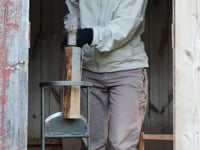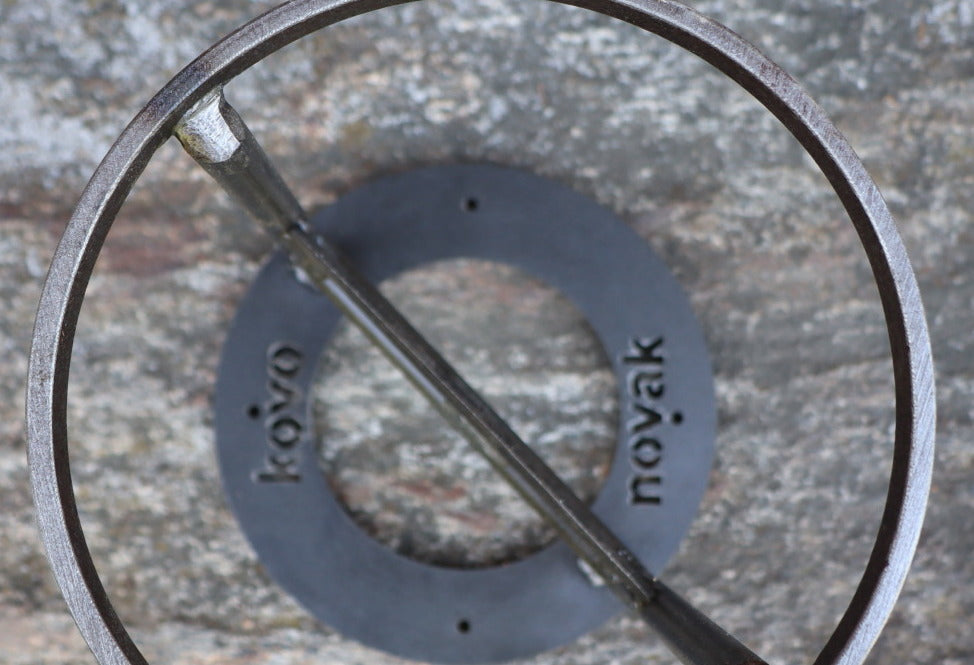Manual wood splitter
Manual wood splitter
Couldn't load pickup availability
This manual wood splitter is a great tool for chopping firewood and making kindling. Its use is safer than using an axe and, under supervision, it is also suitable for use by children and young people or to make everyday life easier for the elderly.
Best of all, the splitter does not require electricity or other fuels to function but chops wood faithfully in any situation. It is of sturdy construction and also a good tool if people want to prepare for crisis situations.
The wood splitter operates in a way that turns the traditional use of an axe upside down. The firewood is placed on top of the blade and not the other way around. After that, just a tap with a bigger hammer or a mallet on the wood and the wood splits without the blade having had a chance to get lost in the chopper's leg, as might happen when chopping wood with an axe.
If you want to split larger pieces of firewood, a mallet slightly under two kilos has proven to work well. If you want to chop already split pieces into even smaller pieces, a lighter mallet or even a hammer is enough. Then you can get by with a tool weighing about a kilo. A mallet that is too heavy in relation to the size of the piece of firewood should be avoided, because then the wood may split too easily, so that the mallet may even hit the blade after first splitting the wood, thus dulling it.
It is definitely worth screwing the splitter to a wooden splitting block. In this way it does not move during work and the force of the impact is directed straigth to splitting the wood and does not dissipate into the air when both the splitter and the piece of firewood move. To attach the splitter use the four holes in the splitter’s lower frame. Four screws are supplied with the splitter.
The splitter is at its best when working on slightly softer wood and is not very fond of knotty wood; in the latter case the piece of firewood may get stuck and you have to reverse it out of the stand by hitting it in the other direction. If there is a branch in the piece of wood, it should be placed parallel to the blade and you should split the wood next to the branch. If you try to split a branch, it might work, but sometimes it doesn't. The splitter is particularly handy when making kindling, and kindling are created in the blink of an eye. Of course it is also possible to chop larger quantities of wood, but for splitting an entire year’s demand of firewood, you should nevertheless use more robust equipment.
This manual wood splitter is made of hardened steel in the Czech Republic and the blade is very hard and durable. The manufacturer Kovo Novák is a family business that produces agricultural machinery and uses high-quality European metal as raw material for their machines. For these splitters, the company partially uses left-over metal pipes from the production of other machines, which otherwise would end up as waste, i.e. circular economy at its best! Therefore, the diameter of the manual splitter varies slightly from one batch to another, depending on the size of scrap metal available at any given time. That's why the outer diameter of these splitters is either 22 cm or 24.5 cm, both equally functional. The splitter's height is 38.5 cm and weighs about 4 kg. The blade is very hard, but if it gets a little dull with heavy use, it can be sharpened.
Among the photos you see a picture from the production site of the wood splitter where one production step has just been completed. The blade will be added to the frame in the next production step.
The surface of the splitter has been treated with Finnish organic rapeseed oil and there is no other treatment such as varnish or paint because it would wear off over time and end up polluting nature for no reason. If you want to keep the surface protected, you can add another layer of oil from time to time. If the splitter is not oiled, its surface may rust little by little, but this does not affect the performance of the splitter in any way. It's just a cosmetic disadvantage, if you even want to consider it a disadvantage.
As with all work of this type, remember to protect your hands with work gloves, your eyes with glasses from possible flying splinters, and your ears with hearing protection when using the splitter to chop wood!













